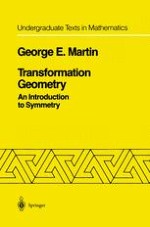1982 | OriginalPaper | Chapter
Even Isometries
Author : George E. Martin
Published in: Transformation Geometry
Publisher: Springer New York
Included in: Professional Book Archive
Activate our intelligent search to find suitable subject content or patents.
Select sections of text to find matching patents with Artificial Intelligence. powered by
Select sections of text to find additional relevant content using AI-assisted search. powered by
A product of two reflections is a translation or a rotation. By considering the fixed points of each, we see that neither a translation nor a rotation can be equal to a reflection. Thus, σnσm ≠ σl for lines l,m,n When a given isometry is expressed as a product of reflections, the number of reflections is not invariant; indeed, we can always add 2 to the number of reflections in a given product by inserting “σlσl” into the product. Although a product of two reflections cannot be a reflection, we know that in some cases a product of three reflections is a reflection. We shall see this is possible only because both 3 and 1 are odd integers. In mathematics, parity refers to the property of an integer being either even or odd. An isometry that is a product of an even number of reflections is said to be even; an isometry that is a product of an odd number of reflections is said to be odd. Since an isometry is a product of reflections, then an isometry is even or odd. However, the definition will be useful only if we show that no isometry is both even and odd. Of course no integer can be both even and odd, but is it not conceivable some product of ten reflections could be equal to some product of seven reflections? To show this is impossible, we first show that a product of four reflections is always equal to a product of two reflections.
